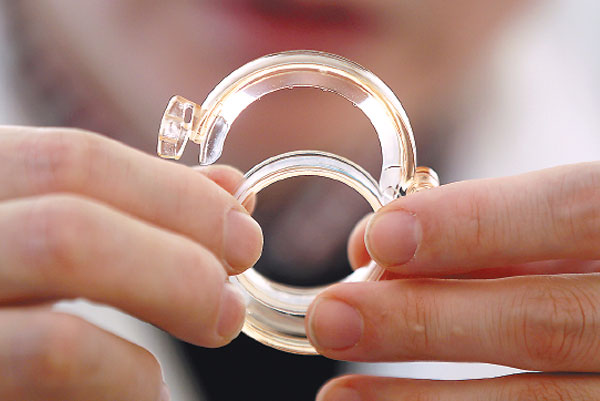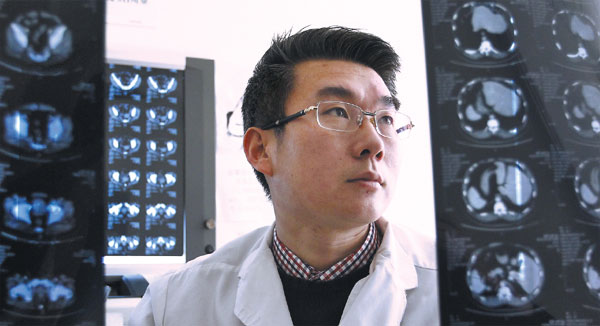【媒體報道】《China Daily》 Ringing the changes for circumcision
發布日期:2015-02-05 瀏覽次數:2206
原文鏈接如下:http://europe.chinadaily.com.cn/china/2015-02/05/content_19495312.htm
Updated: 2015-02-05 07:41
By Yang Wanli(China Daily)
A Chinese invention may promote the procedure at home, and help in the battle against HIV/AIDS overseas, as Yang Wanli reports.
On April 4, 2012, Bill Gates visited Stanford University for a question and answer session with students. During a brief presentation on the innovations that are helping African countries, the billionaire Microsoft boss showed off an ingenious invention from China. It was small, pink, and consisted of two concentric plastic rings. "It's a fantastic development. It's just plastic, so it's very cheap," he said. "It reduces the pain involved. It reduces the cost involved. It's very straightforward."
Fast-forward almost three years. It's January, and an electrician is installing bulbs to meet lighting standards on the production line at Wuhu Snnda Medical Treatment Appliance Technology Co in East China's Anhui province. If the invention Gates displayed at Stanford passes the World Health Organization's prequalification process in the next few months, Wuhu Snnda will begin full production.

Shang Ring consists of two concentric plastic rings. The use of the ring for circumcision leaves no scars and the patient feels very little pain during the procedure. Zhang Wei / China Daily

Doctors at work in the urology department of the Air Force General Hospital in Beijing. In China, the male circumcision rate is lower than 5 percent. Han Meng / China Daily

Tian Long, director of the urology department in Chaoyang Hospital in Beijing, checks an X-ray. The department performs about 1,000 circumcisions every year, and most patients opt for the Shang Ring, even though it costs 1,200 yuan ($192) to 1,300 yuan, double that of conventional surgery. Zhang Wei / China Daily
The device, called the Shang Ring after its inventor, Shang Jianzhong, is the latest development in circumcision - the surgical removal of the foreskin, the retractable fold of tissue that covers the head of the penis.
Shang always laughs when he recalls the circumcision he had 13 years ago to treat an ailment, but the 60-year-old's experience was far from humorous. The surgery, performed at a clinic in Anhui, took 30 minutes as the surgeon snipped the foreskin and then stitched the wound in the classic procedure that's performed every day in some part of the world. After the operation, Shang was put on a drip and given oral antibiotics to prevent infection. He was also banned from taking a shower for seven days.
A month later, however, the results were unsatisfactory. The surgery had left several prominent scars, and "even more embarrassing was that the surgeon had cut the foreskin a little more than necessary, and my erection became shorter than before", Shang said. Experts say these "defects" may be unavoidable with conventional surgery; the scars are caused by the stitches, and the length of the foreskin always depends on the individual surgeon's technique.
In light of the problems he'd encountered, Shang, who spent eight years as a mold-maker before working as a surveyor at a mapping institute, decided to put his technical skills to good use and design a device to aid circumcision.
The result was the Shang Ring, a disposable device consisting of two concentric rings that clamp together and expose the foreskin so it can be removed surgically, but with minimal bleeding. The ring is removed seven days after the surgery when the wound has healed. Because the procedure doesn't require stitches, the patient is allowed to bathe and only requires oral antibiotics. The use of the ring also cuts the procedure time to about three to five minutes from about 30 before.
"People may be surprised to learn that such an innovative idea was nurtured in China, where the circumcision rate is extremely low," Shang said. "My reply is this: No matter how many circumcisions have been done in a country, each one is extremely important to the man concerned, to his health and self-confidence. A safer, semi-surgical device will encourage more people to learn about circumcision, and maybe choose to have the procedure."
AIDS prevention strategy
The World Health Organization estimates that about 30 percent of all males aged 15 and older worldwide are circumcised, and about 70 percent of them are Muslim or Jewish. Although the practice is most prevalent in Judaism and Islam, and is carried out during childhood or around puberty as part of a rite of passage, it's also common among Christians in Egypt, Syria and a small number of other countries. In China, the male circumcision rate is lower than 5 percent.
In 2007, WHO and UNAIDS, the Joint United Nations Program on HIV/AIDS, issued guidelines on using medical male circumcision as an additional strategy to prevent HIV infection. According to the US Centers for Disease Control and Prevention, clinical trials have demonstrated that circumcision reduces the risk of contracting HIV/AIDS by 50 to 60 percent. The procedure also reduces the chances of contracting herpes and human papilloma virus, two pathogens believed to cause cancer of the penis, by 30 percent.
However, circumcision is still almost unknown in China, according to Zhou Xiao-zheng, a professor of sociology at Renmin University of China. "Few Chinese men have a religious background that promotes circumcision. In addition, surgery on the male genitals remains unthinkable. In the minds of the Chinese people, the only equivalent widely known surgery is the castration of eunuchs, which can be traced back to the Qin Dynasty (221-206 BC)," he said.
According to Zhu Jichuan, director of the Andrology Center at Peking University Hospital, the traditional notion that "only a patient needs surgery" is deeply rooted. "Most men choose to be circumcised because of a skin inflammation that results from having an overlong foreskin, rather than to prevent disease. However, surgery is an option that must be open to them," he said.
That reluctance is also a result of the defects of conventional surgery, because scars and the risks related to bleeding are inevitable, Zhu said. "More important, the amount of foreskin removed can't be targeted by the millimeter, so some men may be concerned that their erections will be shorter after surgery," he said.
Whatever their concerns, the patients have high expectations. The urology department at Chaoyang Hospital in Beijing performs about 1,000 circumcisions every year, and most patients opt for the Shang Ring, even though it costs 1,200 yuan ($192) to 1,300 yuan, double that of conventional surgery, according to Tian Long, director of the department.
"People expect more nowadays. Not just in terms of safe removal of the foreskin, but also in terms of good appearance and perfect function," Tian said. "To a surgeon, circumcision is actually a challenging operation, not because it's complicated, but because it requires an exquisite technique."
Although some private hospitals advertise "painless laser-scalpel surgery" to encourage people to have the traditional operation, the differences are minimal. "They just revolve around the type of anesthesia and surgical instruments; the procedure is fundamentally the same," he said.
Philip S. Li, associate research professor of urology at the Weill Cornell Medical College of Cornell University, said that in the past three years, the male circumcision rate in the US has been around 70 percent.
Li said the surgery is usually performed within a day or two of a baby's birth. However, doctors may also suggest circumcision for older patients who are experiencing problems, such as inflammation of the foreskin, or phimosis, difficulty in retracting the foreskin.
Tian, from Chaoyang Hospital, said the circumcision of newborns is almost unknown to most Chinese parents, but an increasing number of the younger generation is embracing the practice. In recent years, students have accounted for nearly 50 percent of all surgical cases at Chaoyang Hospital and Peking University Hospital during the winter and summer vacations.
According to Tian, another sizable patient group consists of men aged about 30 who are about to marry, and choose to have the surgery to reduce the risk of the bride contracting a bacterial infection.
Changing attitudes
Zhou Junchen, 32, opted to be circumcised at the age of 20 after reading on the Internet that the operation would reduce the risk of infection and also provide better-quality sex. "Dozens of men were having the operation that morning, and the surgeon was surprised when I lay on the operating table. He said he rarely treated younger patients who had chosen to have the surgery voluntarily for health reasons. Most of his cases involved older men with inflammations," he said.
Things have changed in the intervening 12 years, though. Zhou said young people have a more open-minded attitude toward circumcision, and want to learn more about it. "Although the benefits haven't been widely publicized in China, people now have greater access to health information. I believe people of my generation will consider this as an option for their kids," he said.
The Shang Ring has been adopted by a number of hospitals around China, and some experts believe that the growth of the market will benefit an increasing number of people, who will in turn encourage others to learn about circumcision.
"More important, the Shang Ring could vastly increase access to male circumcision in countries hardest hit by the HIV epidemic," said Cornell's Li. The significance of circumcision has already been shown in some Africa countries, because the surgery has been gradually promoted across the continent in the past decade.
In 2011, a UNAIDS report showed a decline in the number of new cases of HIV in 33 countries - 22 of them in southern Africa - between 1997 and 2010. Although medical interventions, such as the introduction of antiretroviral therapies, were the main reasons for the fall, the report said circumcision had also played an important role in the prevention of HIV and other sexually transmitted diseases.
"The Shang Ring is a great contribution that China has made to global health," said Cheng Feng, program director of the Research Center for Public Health at Tsinghua University. "Once it passes the WHO's prequalification process, the United Nations could purchase it for large-scale use in Africa, where there are so few medical staff. That could mean a lot for African countries - in the long term it could even prove to be of greater value than materials provided to support the continent as it changes. It's not just about today - it's also about the future."
Contact the writer at yangwanli@chinadaily.com.cn
(China Daily 02/05/2015 )





